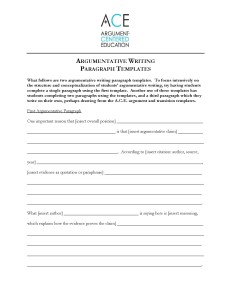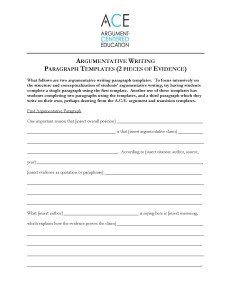
Building an Argument (Not a Wall), Using Templates
Working with one of its middle school partners, Argument-Centered Education recently supported but largely observed an English language arts class building arguments from a single source, on the debatable issue of what U.S. policy should be on undocumented residents. The debatable issue was specifically formulated:
Should the United States offer a pathway to citizenship for the millions of undocumented residents currently living in the U.S.?
This argument writing activity was designed to be brief, its full duration only a few days, so after a short video clip introducing the issue, followed by a think-pair-share discussion emphasizing the factual backdrop and issue-specific vocabulary, students read a single article, from the New York Times Upfront Magazine, from which they were expected to derive most of their evidence, and a good portion of their ideas.
 Students were to write two or three argument paragraphs defending and developing one of two positions, either
Students were to write two or three argument paragraphs defending and developing one of two positions, either
The United States should offer the 11 million undocumented residents currently in this country a pathway to citizenship.
Or
The United States should deport the 11 million illegal immigrants currently in this country.
Templates
Concomitantly, students used the Argument-Centered Education argument paragraph template that limits each argument to one piece of evidence. If the activity were longer, and there were multiple sources from which the students were to draw their ideas and support for their arguments, the version that incorporates two pieces of evidence would have likely been more suited.
If the activity were longer, and there were multiple sources from which the students were to draw their ideas and support for their arguments, the version that incorporates two pieces of evidence would have likely been more suited.
Assignment
Students who are struggling with their argument writing were assigned to build two arguments by completing the two paragraph template. The other students were assigned to build three arguments, completing those two paragraphs and then building a third argument that uses the structure and sequence of the templated models but not their language. Students have to find their own transitions and constructs to produce a third argument paragraph on their own.
An additional feature (remember, this was a very short project, only about three full class periods). The teacher led the students through the production of one argument on each side of the issue together. In effect, the class collectively assembled every student’s first argument paragraph, so they were obligated to produce only two or one more on their own.
Student Work
Here is the version that a teacher-led middle school class came up with for its first argument to support the position that the U.S. should establish a pathway to citizenship for the 11 undocumented residents currently here, following (of course) the first paragraph argument template in the first template document above.
One important reason that undocumented residents should be allowed a pathway to citizenship is that many of them have American families, and splitting them up would cause serious trauma. According to Senator Charles Schumer, writing in Upfront magazine in 2016, trying to deport undocumented residents, rather than providing them with a legal way of staying in the U.S., would “tear apart families.” What Sen. Schumer is saying here is that the U.S. must create a policy that avoids inflicting suffering and unforgettable pain on millions of children and families. The alternative would be un-American. Now, some might argue that these families are at fault for coming to the U.S. illegally, so the suffering shouldn’t influence American government policy. But the argument that American immigration policy should avoid breaking up these families is still true. The key point is that the children in these families did not make the decision to immigrate illegally. American policy cannot morally inflict suffering on so many children, who will remain innocent victims unless we adopt a pathway to citizenship.
This was the argument produced by students collectively, with minimal teacher guidance, following the ACE template, at a regular neighborhood middle school. Pretty solid work, I’m sure you’ll agree.
There are several features of the argument that are notable.
“Framing” the Debate
Less about the argument than the position statement options above, but the teacher presented a mini-lesson after introducing the position statements on “framing language” on an issue. Advocates enmeshed in a controversy often attempt to “frame” or stilt a debate by choosing language with connotative weighting that favors their side. Examples abound — “pro-life” vs. “pro-choice” in the abortion debate, “tax reform” vs. “tax cuts for the rich” on the taxes issue — and for this issue students were introduced to the way that those who emphasize the harms done to the U.S. by undocumented immigration use the label “illegal immigrants,” while those who see little if any threat from this group use the label “undocumented residents.” Why these phrases have weight, and how they themselves convey an argumentative valence, are the animating questions of this mini-lesson.
Pointed Reasons :: Argumentative Claims
“Serious trauma” wasn’t the first phrase the students came up with to put a point on the argumentative claim, but it was one they created. In order to be a reason that this group should be given a pathway to citizenship, there has to be a specific benefit relative to the other position, or (as in this instance) a specific harm brought by the other position.
Combining Quotation and Paraphrase in Evidence
The article has brief statements from Sen. Charles Schumer and Rep. Steve King, so the evidence is going to spare. That gave the teacher an opportunity to introduce the hybrid option between quotation and paraphrase, when the writer doesn’t have a full passage or even sentence to quote, but rather a few words, and contextualizes that quote with his or her own broader textual paraphrase.
Reasoning as Evidence Booster
Often times reasoning, in order to “emphasize” the importance of evidence and its effect on the authority and strength of an argumentative claim, has to act as a magnifier or booster of that evidence, supplying what is unstated and implied in the text that would strengthen the force of it as evidence. In this instance, the students came up together (after being prodded with a description of this reasoning function) that when Sen. Schumer says that deportation would “tear families apart” he’s implying the deeply traumatic consequences that he believes such a policy outcome would have. He also rather clearly implies in his final paragraph (and its references to the Statue of Liberty) that such a policy that inflicted such suffering on otherwise law-abiding families would be un-American; thus the next sentence of reasoning. What’s crucial here — and what the class had a good opportunity to discuss — is that this reasoning be both an evidence booster, and evidence-connected, and not speculative or far afield from what the text says or implies.
Specificity of the Counter-Argument
Counter-arguments, in order to be generated from and generative of, critical thinking should be specific to the argument they are countering. They are counter-arguments, not counter-positions. This example we honed into one in which the students identified the argument that families’ suffering is not the fault or concern of the U.S. government because they broke the law in entering U.S. territory. Note, too, that this particular counter-argument led to an adapted phrasing of the next sentence, the refutational statement; to avoid it coming out awkwardly, we agreed to formulate re-statement of the claim as “U.S. policy should avoid breaking up families.” Students saw the content-equivalence between this statement and the original claim.
Honing in on the Nexus of Disagreement in the Refutation
The template language has students hone in on the nexus point of their disagreement with the counter-argument as they refute it. “The key point is . . . ” leads them to pare away all but the nub of critical thinking that directly addresses the force of the counter-argument. So, here, that means that the counter-argument may be right about the adults who entered into the country illegally, but it says nothing about the children in these families, none of whom deserve to be — or can morally be — traumatized by U.S. enforcement of its immigration policy. The students developed and then reflected on how fitting their refutation in this instance was.
Students at this partner school have been working on their second and third paragraphs and have just recently turned them in. Initially their argumentation looks strong, and perhaps a future post will identify examples of advancements in academic argument visible in their work. The Debatifier will in a near-term post investigate the use of the Graffean “front the counter-argument” versions of these templates, ones where in each argument the opening is what others say that the writer will differ or disagree with.


